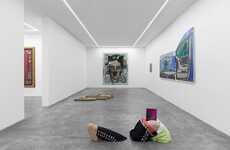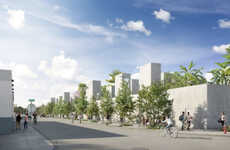
Odisea 20 Cultural Slum
Hernando Gomez Salinas — November 13, 2007 — Art & Design
References: myspace & baspotting.blogspot
In the city of Buenos Aires, like in other Latin American cities, there are settlements of impoverished people called "villas" (slums) because the savage capitalism has wreaked havoc on them.
Social relations and a strong sense of belonging are generated in the villas of Buenos Aires. These bonds are so strong, they generated a culture, "Subculture" and a resistance culture.
Due to the cultural production in the slum, MartÃn Roisi (A.k.a Fantasma) thought that he could create a cultural space in Buenos Aires called Odisea 20 (Odissey 20), a cultural producer located in the middle of the Slum 20 in the village of Villa Lugano.
It supports and sponsors cinema productions, painting, photography, music and plastic arts. After a cultural production has been shown for many years, they decided to show the first exhibition of Slummy Art in Boquitas Pintadas of San Cristóbal, Buenos Aires. The place serves as an art gallery from 11 a.m. to 6 p.m. and it exhibits paintings, photographs, sculptures, serigraphs, and murals by artists who dwell in the slums 20, 21, 31, and 31 A, Piedrabuena, Barracas, Zavaleta and Soldati. An orchestra composed of kids of the Slum 31 plays every Thursday.
Check Arte Villero myspace here.
Social relations and a strong sense of belonging are generated in the villas of Buenos Aires. These bonds are so strong, they generated a culture, "Subculture" and a resistance culture.
Due to the cultural production in the slum, MartÃn Roisi (A.k.a Fantasma) thought that he could create a cultural space in Buenos Aires called Odisea 20 (Odissey 20), a cultural producer located in the middle of the Slum 20 in the village of Villa Lugano.
It supports and sponsors cinema productions, painting, photography, music and plastic arts. After a cultural production has been shown for many years, they decided to show the first exhibition of Slummy Art in Boquitas Pintadas of San Cristóbal, Buenos Aires. The place serves as an art gallery from 11 a.m. to 6 p.m. and it exhibits paintings, photographs, sculptures, serigraphs, and murals by artists who dwell in the slums 20, 21, 31, and 31 A, Piedrabuena, Barracas, Zavaleta and Soldati. An orchestra composed of kids of the Slum 31 plays every Thursday.
Check Arte Villero myspace here.
Trend Themes
1. Subcultural Art - There is an opportunity for the art industry to embrace subcultural art produced by those living in impoverished areas, offering a new lens through which to view the world.
2. Resistance Culture - There is an opportunity for businesses and organizations to learn from the strong sense of belonging and social relations found in resistance cultures in order to foster community and loyalty among employees and customers.
3. Cultural Production - By supporting cultural production in impoverished areas and offering a platform for artists to showcase their work, there is an opportunity to promote and celebrate diverse perspectives and creativity.
Industry Implications
1. Art - The art industry can benefit from collaborating with and supporting artists in impoverished areas to showcase subcultural art and promote diversity.
2. Community Development - Through supporting and fostering the unique cultures and social relations found in impoverished communities, there is an opportunity for the community development industry to promote empowerment, resilience, and inclusion.
3. Social Entrepreneurship - By supporting and sponsoring cultural production in impoverished areas and offering a platform for artists to showcase their work, there is an opportunity for social entrepreneurs to promote social and cultural change, addressing issues of inequality and injustice.
2.7
Score
Popularity
Activity
Freshness























